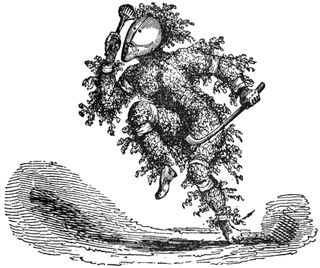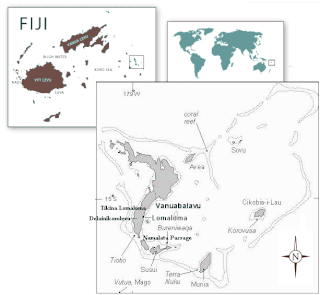This article needs additional citations for verification .(December 2007) |
Sau Mai Kedekede now more commonly referred to as Sau ni Vanua ko Lau is one of the preeminent titles held by the Paramount Chief of the Lau Islands in Fiji.
This article needs additional citations for verification .(December 2007) |
Sau Mai Kedekede now more commonly referred to as Sau ni Vanua ko Lau is one of the preeminent titles held by the Paramount Chief of the Lau Islands in Fiji.
The title Sau Mai Kedekede originates from the Tongan word “Hau”, denoting the divine nature of the Tu'i Tonga suggesting the frequent intercourse amongst the chiefly houses of Lakeba and Tonga in pre-Christian times. The title of Sau is considered much older and is independent of the title Tui Nayau, now held in tandem by the Paramount Chief of the Lau Islands, as its original holders were from the island of Lakeba (pre-Vuanirewa dynasty).
The first recorded holder of the title was Qilaiso and through him and his three descendants and successors, all of the southern Lau Islands(Moce, Kabara, Fulaga, Ono-i- Lau and their dependencies) was brought into Lakeba's control and suzerainty. The Sau title eventually merged in time with the title Tui Nayau, and its dual usage commenced in the person of Rasolo. Both titles Sau Mai Kedekede and Tui Nayau are now inextricably linked, and heirs succeeding to the title Tui Nayau cannot do so unless recognised and installed as Sau Ni Vanua.
The investment ceremony for the Sau Ni Vanua takes place in Tubou on Lakeba. Once the elders of the Vuanirewa have endorsed the successor to the previous Tui Nayau, the Ramasi or chief makers and Vakavanua being chief herald are summoned to undertake the ceremony. The Ramasi consists of the Tui Tubou and the Tui Nasaqalau and the vanua represented by the Vakavanua of Ceiekena and Tui Soso (from Nukunuku village). During the ceremony the recipient will have a piece of bark cloth tied on his arms by each of the Ramasi and the coronation turban or salasiga placed upon his head by the Vakavanua. He also receives the coronation cup containing kava from the vakavanua, which he must drink to affirm his becoming Sau Ni Vanua O Lau. This is then followed by a general kava ceremony where principal chiefs of rank in Lau drink in turn, ceremonial titles are conferred by the Sau and gifts are presented by his people. The Sau's installation concludes with the removal of the arm bands and ritual bath after four days.
The historical holders of the title of Sau Mai Kedekede:
Of the Ceiekena Dynasty (16–17th century):
Levuka Occupancy of Lakeba (early to mid-18th century)
The Vuanirewa Dynasty (mid-18th century to present) (title merges with Tui Nayau title in the person of Rasolo)

ʻEnele Maʻafuʻotuʻitonga, commonly known as Maʻafu, was a Pacific islander who held important titles in two countries in the Pacific. He was a traditional Tongan Prince and a Fijian chief nominated and installed by the Tovata chiefs of Lakeba and Vanua Balavu as 'Tui Lau' in 1869. This title was ratified by a wider council of Fijian chiefs and subsequently formalised under British colonial administration. In 1847, Maʻafu went to Fiji in an expedition to Vanua Balavu to investigate the killing of a preacher.
The Vuanirewa is the ruling tribe (yavusa) of the Lau Islands, a scattered group of more than a hundred islands and reefs along the eastern edge of Fiji.
Niumataiwalu was a Fijian high chief. The name Niumataiwalu, translated as "I came first to Walu beach", was in memory of his grandfather Naosara for winning the leadership contest among Rokomautu's seventeen grandchildren at Walu beach, Verata. Niumataiwalu's father, Delaivugalei, was the younger brother of Qoma, whose father was Kalouyalewa.
Uluilakeba was the eldest son of Niumataiwalu. He did not succeed to his fathers title, first since his father was not known to have been installed to the title of either Tui Nayau or Sau ni Vanua ko Lau, second in the test of feat that had ensued to select the candidate for the title of Tui Nayau he was known to have been one of the two sons of Niumataiwalu who had backed down from the unnerving jump that was put to them by the Bete. In that test of feat it was said as related orally that he as an excuse to allay any possible accusation of cowardice on his part said that since he was the eldest his claim to the title was already established by birthright and thence there was no need for him to prove himself. Rasolo then on the account of his elder brothers excuse, the second eldest of the three then took up the challenge, after Matawalu the youngest had also surrendered up any idea of contesting.
Rasolo was a Fijian High Chief.
The Lau Islands of Fiji are situated in the southern Pacific Ocean, just east of the Koro Sea. Of this chain of about sixty islands and islets, about thirty are inhabited. The Lau Group covers a land area of 188 square miles, and had a population of 10,683 at the most recent census in 2007. While most of the northern Lau Group are high islands of volcanic origin, those of the south are mostly carbonate low islands.

Lakeba is an island in Fiji’s Southern Lau Archipelago; the provincial capital of Lau is located here. The island is the tenth largest in Fiji, with a land area of nearly 60 square kilometers. It is fertile and well watered, and encircled by a 29-kilometer road. Its closest neighbors are Aiwa and Nayau. Separated by deep sea from the latter but only by shallow waters from the former, when sea levels were lower during glacial episodes Lakeba and Aiwa formed one large island.
Dranivia was an 18th-century Lauan chief and noble of the Vuanirewa dynasty. He was the third son of Uluilakeba I and last recorded member of the noble household, Naivi, to hold the title Roko Sau of the Lau Islands. He is referred to as an usurper and often oral history does not include hims as a Roko Sau. He is said to have snatched the chieftainship during the absence of his uncle Matawalu from Lakeba, and without the consent of the Vuanirewa. On hearing of his nephew's treachery, Matawalu returned from Bau and reasserted his authority, while Dranivia was touring the Southern Lau islands. Dranivia immediately returned to Lakeba which precipitated in kin slaying amongst the Vuanirewa. Dranivia was defeated and he fled with his supporters to Nayau and establishing the village of Liku.

Lomaloma is a village at the south of the island of Vanua Balavu in the Lau archipelago of Fiji. The settlement is part of the tribal district of Tikina, Lomaloma and consists of 9 villages, 13 Yavusa (tribes), 42 Mataqali (clans), and 54 family units known as Tokatoka. The nine villages of Lomaloma Tikina are Lomaloma, Sawana, Susui, Narocivo, Namalata, Uruone, Levukana, Dakuilomaloma, and Tuvuca.
Viliame (William) Vuetasau (c.1820-1857) was a Fijian explorer who was the son of Roko Malani, the seventh Roko Sau of Lau and second Tui Nayau and Ciri of Taqalevu. During the reign of his Uncle Taliai Tupou, third Tui Nayau, he was considered heir to the title. He was the first of his noble line to be given a western name, William, after Willam Cary, survivor of the Nantucket whaling ship Oeno that was wrecked in the Lau Islands in 1825. William Cary was rescued by a brother of Malani, who in time became close friends with Malani himself, who named his son after the New Englander, demonstrating his attachment to the shipwrecked sailor.
Matawalu was a Fijian chief. He was the son of Niumataiwalu—first Roko Sau of Lau Islands—and Uma of Nukunuku.
Ratu Alifereti Finau was the eleventh Sau ni Vanua of Lau and the fifth Tui Nayau. He was a member of the noble household Matailakeba.
Toki Soroaqali was a Lauan chief and member of the noble dynasty of Vuanirewa in Fiji, active in the late 1700s and early 1800s.
Roko Taliai Tupou (17??-1875) was a Fijian nobleman. He is considered to be the progenitor of the noble household Vatuwaqa in the chiefly Vuanirewa clan and as such, was the first member of this noble household to hold the title Tui Nayau. His reign marked the growth of Christianity in Lau and the slow expansion of Tongan ambitions in Fiji, led by Enele Ma'afu. As this period marked increasing contact with Europeans, records from this point forward in regard to the history of Lau are well documented.

Delailoa was a Fijian High Chief.

Turaga na Rasau is a traditional Fijian chiefly title of the Lau Islands. Prior to Fiji's colonial days, Fiji had many different Vanua with their own Paramount Chieftain which exercised no authority over the other; a saying from the island of Kadavu aptly summarises it "Nomu Turaga o sega na noqu Turaga" or "Your Chief is not my Chief" also the people of Beqa Island were of a similar opinion saying "Qali Cuva Ki Lagi" or "Subject only to heaven" and would bow to no outside Chieftain, but at the turn of the 20th century aspects of the traditional social structure remained, but for administrative purposes three main Matanitu were solidified and formed as they were the dominant consolidated powers at the time being that of Kubuna, Burebasaga and Tovata. With regard to the Rasau while its traditional origins were in Kubuna on Bau the titles traditional authority in modern Fiji is now in Tovata, Lau in particular Lomaloma Tikina on the Island of Vanua Balavu.
Kapaiwai Tuimacilai Mara, chiefly seafarer, and descendant of the Vunivalu of Bau.
Ratu Tevita Uluilakeba III was the 12th Tui Nayau and Sau ni Vanua of the Lau Islands. He was the father of Ratu Sir Kamisese Mara, founding father of the modern nation of Fiji.
Kalouyalewa was a Fijian High Chief.
Ratu Jione Atonio Rabici "Tom" Doviverata was a Bau chief and medical doctor and administrator in colonial Fiji.